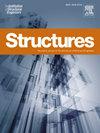Serviceability fragility assessment of non-seismically designed railway viaducts in Turkey under near-field and far-field earthquakes
IF 3.9
2区 工程技术
Q1 ENGINEERING, CIVIL
引用次数: 0
Abstract
While many railway viaducts still in use in Turkish railway networks are located on active fault zones that produced historical destructive earthquakes, they are not seismically designed in accordance to current standards. This study aims to provide a better understanding about the serviceability fragility of such systems by conducting detailed probability-based seismic assessments under near-field and far-field earthquakes. To achieve this, firstly, 3D finite element models of a range of selected viaducts in Turkey were generated based on their original design drawings. The developed FE models were validated by comparing the analytical modal frequencies with the results of in-situ dynamic tests involving a series of acceleration measurements. Nonlinear time history analyses were then carried out under 25 near-field and 25 far-field real three-component ground motion recordings to obtain the seismic response of each selected viaduct. Subsequently, probabilistic seismic demand models were defined using linear regression analysis to determine relationships between engineering demand parameters (EDPs) and ground motion intensity measures (IMs). Peak ground acceleration (PGA), peak ground velocity (PGV) and spectral acceleration at 1.0 s (Sa (1.0)) were used as the IM parameter, while the maximum lateral displacement of the bridge spans for different service velocities defined in the Eurocode was considered as the EDP at serviceability damage state. Finally, analytical fragility curves for all the selected railway viaducts were developed considering maximum damage probability for the IM levels. The results, in general, demonstrate the seismic vulnerability of the existing viaducts in Turkey. It is shown that while at low speed limits the viaducts exposed to far-field ground motions were more vulnerable than those under near-field ground motions, at high speed limits the viaducts subjected to near-field ground motions were more vulnerable. Also, it is seen that reinforced concrete and masonry viaducts are generally more vulnerable to earthquakes than the steel viaducts. The outcomes of this study should prove useful for the seismic risk assessment, loss estimation and rehabilitation of the railway transportation networks in future studies.土耳其非抗震设计铁路高架桥在近场和远场地震下的适用性脆性评估
土耳其铁路网中仍在使用的许多铁路高架桥都位于历史上曾发生过破坏性地震的活动断层带上,但它们的抗震设计并不符合现行标准。本研究旨在通过在近场和远场地震下进行详细的基于概率的地震评估,更好地了解此类系统的适用性脆性。为此,首先根据原始设计图纸生成了土耳其一系列选定高架桥的三维有限元模型。通过将分析模态频率与涉及一系列加速度测量的现场动态测试结果进行比较,对所开发的有限元模型进行了验证。然后,在 25 次近场和 25 次远场真实三分量地面运动记录下进行了非线性时间历程分析,以获得每座选定高架桥的地震响应。随后,利用线性回归分析确定了概率地震需求模型,以确定工程需求参数(EDPs)与地动烈度测量值(IMs)之间的关系。峰值地动加速度(PGA)、峰值地动速度(PGV)和 1.0 秒时的频谱加速度(Sa (1.0))被用作地动烈度参数,而《欧洲规范》中规定的不同使用速度下桥跨的最大横向位移则被视为适用性破坏状态下的工程需求参数。最后,考虑到 IM 水平的最大损坏概率,为所有选定的铁路高架桥绘制了分析脆性曲线。总体而言,研究结果表明了土耳其现有高架桥的抗震脆弱性。结果表明,在低速限情况下,受远场地动影响的高架桥比受近场地动影响的高架桥更脆弱,而在高速限情况下,受近场地动影响的高架桥更脆弱。此外,钢筋混凝土和砖石结构的高架桥一般比钢结构的高架桥更容易受到地震的影响。这项研究的成果将有助于今后铁路交通网络的地震风险评估、损失估计和修复。
本文章由计算机程序翻译,如有差异,请以英文原文为准。
求助全文
约1分钟内获得全文
求助全文
来源期刊

Structures
Engineering-Architecture
CiteScore
5.70
自引率
17.10%
发文量
1187
期刊介绍:
Structures aims to publish internationally-leading research across the full breadth of structural engineering. Papers for Structures are particularly welcome in which high-quality research will benefit from wide readership of academics and practitioners such that not only high citation rates but also tangible industrial-related pathways to impact are achieved.
 求助内容:
求助内容: 应助结果提醒方式:
应助结果提醒方式:


